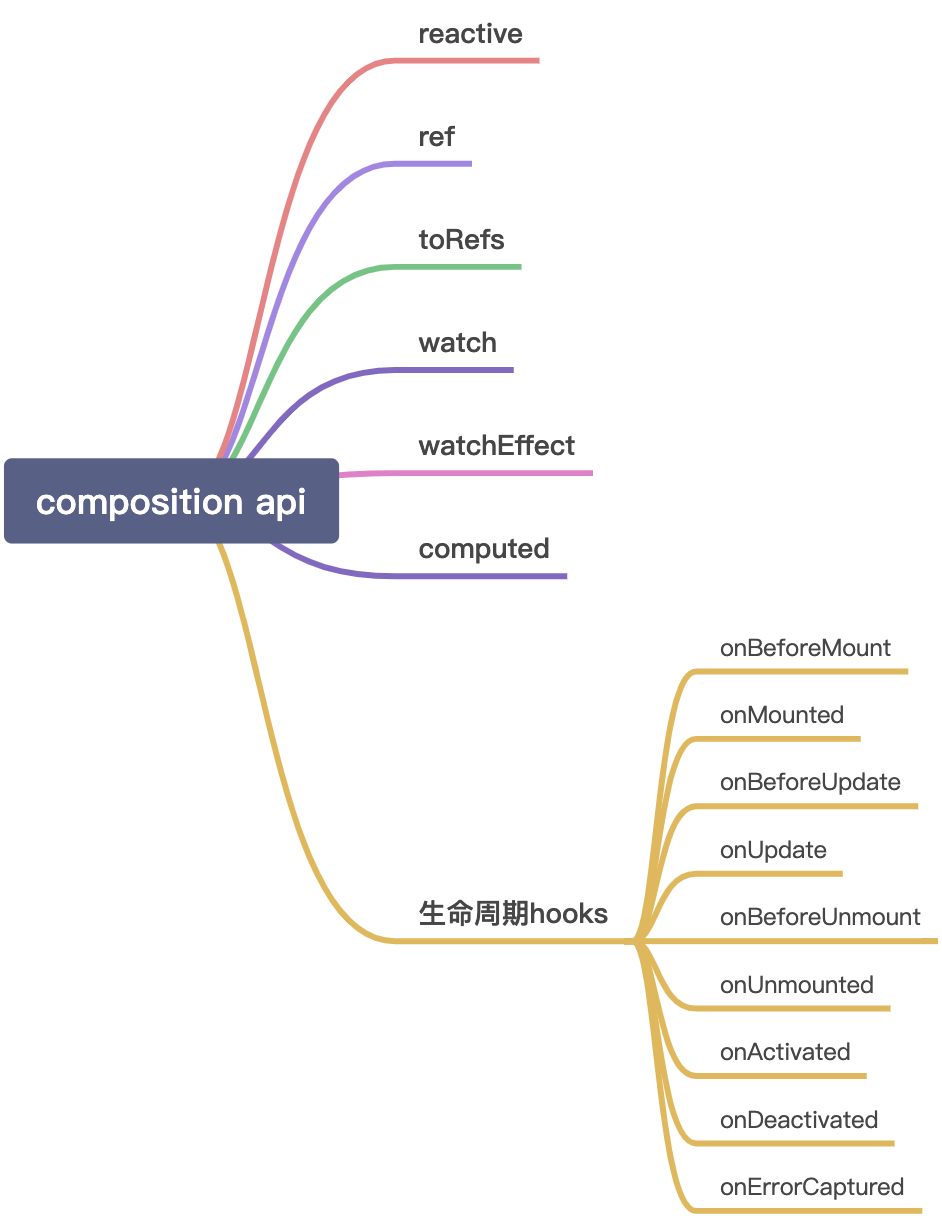Vue3.0 composition api 特性學習
options-api
首先咱們來看看 option-api。javascript
default export {
data() {
return {
state:0
}
},
methods:{
myFun() {
console.log(this.state)
}
}
}
上面代碼的方式就是 option-api, 也是 vue2.x 中最經常使用的方式。
vue
composition-api
在vue3.x中,可使用下面的 composition-api 方式。java
default export {
setup(){
const state = ref(0)
function myFunOne() {
console.log(state.value)
}
function myFunTwo() {
console.log(state.value + 1)
}
return {
state,
myFunOne
}
}
}
解決痛點
看下面的圖片(來源:https://composition-api.vuejs.org/#code-organization),相同業務的代碼顏色相同,能夠看見 Options API 的相同業務代碼分散在各處,這樣後期維護起來就會很是麻煩,而Composition-Api 解決了這個痛點。
node
知識點梳理
 關於 composition-api 所包含的函數有以上這麼多,下面根據相關例子一個個來學習。
關於 composition-api 所包含的函數有以上這麼多,下面根據相關例子一個個來學習。
react
setup
setup功能是新的組件選項。它是組件內部使用Composition-API的入口。
vue-router
可選參數
它有兩個可選參數 props 和 context。
這兩個參數能夠解構使用。api
- props 和 vue2.x props是同樣的,裏面的屬性是 父組件傳給自組子或 vue-router 傳給 頁面的參數。
- context具備與vue2.x 中 this.$attrs,this.$slots,this.$emit,this.$parent,this.$root對應的屬性。
示例代碼
props: {
msg: String
},
// 須要在 emits 中聲明 否則會報錯 下面會有解釋
emits: {
sayhi: payload => {
// validate payload by returning a boolean
return payload
}
},
// 1. 通常使用
// setup(props, context) {
// console.log('====>', props)
// context.emit('sayhi', 'hi')
//}
// 2. 可解構使用
setup({ msg }, { emit }) {
console.log('====>', msg)
emit('sayhi', 'hi')
}
注意點⚠️
在 setup 中使用 emit , 須要在emits 中聲明它,不然會報如下錯誤。數組
Extraneous non-emits event listeners (此處是函數名) were passed to component but could not be automatically inherited because component renders fragment or text root nodes. If the listener is intended to be a component custom event listener only, declare it using the "emits" option.
ref
<template>
<div>
<div>{{ state }}</div>
<button @click="addOne">新增1</button>
</div>
</template>
<script lang="ts">
import { defineComponent, ref, onMounted } from "vue"
export default defineComponent({
setup(){
// 經過 ref 初始化一個響應式的對象
const state = ref(0)
// 在生命週期 onMounted 中打印 state
onMounted(() => {
console.log(state)
})
function addOne() {
state.value += 1
}
return {
state,
addOne
}
}
})
</script>
咱們再來看看這段代碼。
在 dom掛載完畢的生命週期 onMounted 中打印 state , 發現它是一個對象。
由於 state 是經過ref 傳參,而後返回的一個對象( ref 是一個函數,它接受一個參數,返回的一個響應式對象 )。咱們初始化的這個 0 做爲參數包裹到這個對象中去,在將來能夠檢測到改變並做出對應的相應。
在 addOne 函數中, 若要改變 這個 state 響應式對象的值, 則須要經過 賦值 state.value 來實現。
在 template 模板中 ,vue 已經幫咱們自動獲取了其 value屬性,因此咱們只須要傳{{ state }} 便可。
dom
reactive
reactive 和 ref 很是類似, 也是一個函數, 可是其接收一個對象。咱們改造上面學習 ref 的 例子來了解 reactive。函數
<template>
<div>
<div>{{ state }}</div>
<button @click="addOne">新增1</button>
</div>
</template>
<script lang="ts">
import { defineComponent, onMounted, reactive, toRefs } from "vue"
export default defineComponent({
setup(){
// 經過 reactive 初始化數據
const data = reactive({
state: 0,
})
// const state = ref(0)
// 在生命週期 onMounted 中打印 state
onMounted(() => {
console.log('無 toRefs', data)
console.log('經過 toRefs 處理', toRefs(data))
})
function addOne() {
data.state += 1
}
return {
// ...data, // 這樣導出會使數據失去響應式
...toRefs(data), // 經過 toRefs 使得 data 中數據得到響應式
addOne
}
}
})
</script>

與 ref 相比:
- reactive 能夠將 零散的 變量彙集在一個對象中。
- reactive 中的變量 的取值和賦值不須要 取其 value 屬性。
注意點:
使用 reactive 時要記得使用 toRefs 保證 reactive 對象屬性保持響應性。
watch 和 watchEffect
代碼示例
// 經過 reactive 初始化數據
const data = reactive({
state: 0,
num: 2,
arr: [1, 2, 3]
})
// 簡單監聽
watch(data, () => {
console.log(data.state)
})
// 下面直接監聽data.state會報錯。watch 監聽的目標只能是getter/effect函數、ref、reactive對象或數組。
// watch(data.state, (newValue, oldValue) => {
// console.log('newValue', newValue)
// console.log('oldValue', oldValue)
// })
// 監聽 新的值和舊值
watch(() => data.state, (newValue, oldValue) => {
console.log('newValue', newValue)
console.log('oldValue', oldValue)
})
// watch 監聽多個屬性,返回的也是多個值的數組
watch([() => data.num, () => data.state], (newValue, oldValue) => {
console.log('old', oldValue)
console.log('new', newValue)
})
// watchEffect 不須要指定監聽的屬性
watchEffect(()=>{
console.log('watchEffect ===>', data.state);
});
watch
A watch source can only be a getter/effect function, a ref, a reactive object, or an array of these types.
watch 監聽源只能是getter/effect函數、ref、reactive對象或數組。
具體用法如上述代碼所見
- 簡單監聽值的改變。
- 能夠獲取到新值與舊值。
watch只能監聽指定的屬性而作出變動,vue3.x能夠同時監聽多個屬性。
watchEffect
watchEffect 和 watch 相似,能夠監聽屬性的變化。具體使用方式如上述代碼。
不一樣點
watchEffect不須要指定監聽的屬性,它會自動的收集依賴,只要咱們回調中引用到了 響應式的屬性, 那麼當這些屬性變動的時候,這個回調都會執行,而watch只能監聽指定的一個或多個屬性而作出變動。-
watch能夠獲取到新值與舊值,而watchEffect是拿不到的oldValue watchEffect在組件初始化的時候就會默認執行一次,而 watch 不須要。
computed
計算屬性和vue2.x 中同樣,代碼示例以下。
<template>
<div>
<div>{{ state }}</div>
<div>{{ double }}</div>
<button @click="addOne">新增1</button>
</div>
</template>
<script lang="ts">
import { computed, defineComponent, reactive, toRefs } from "vue"
export default defineComponent({
setup(){
// 經過 reactive 初始化數據
const data = reactive({
state: 0,
})
// 經過計算屬性得到的新的值
const double = computed(() => data.state * 2)
function addOne() {
data.state += 1
}
return {
...toRefs(data), // 經過 toRefs 使得 data 中數據得到響應式
addOne,
double
}
}
})
</script>
- 1. vue3.0 組合式API(Composition API)
- 2. vue3.0 組合式(Composition)API TodoList
- 3. vue3.0新特性
- 4. vue3.0 Composition API 翻譯版(超長)
- 5. vue3.0 Composition API上手初體驗
- 6. Vue3.0 新特性全面探索 - 基於 Composition Api 快速構建實戰項目
- 7. vue3.0 Composition API 初識 綜合版本(基本新特性+生命週期)
- 8. vue3學習day1(composition-api)
- 9. Vue3 | Composition API 學習總結
- 10. Vue3 Composition API
- 更多相關文章...
- • 您已經學習了 XML Schema,下一步學習什麼呢? - XML Schema 教程
- • 我們已經學習了 SQL,下一步學習什麼呢? - SQL 教程
- • JDK13 GA發佈:5大特性解讀
- • Tomcat學習筆記(史上最全tomcat學習筆記)
-
每一个你不满意的现在,都有一个你没有努力的曾经。
- 1. vue3.0 組合式API(Composition API)
- 2. vue3.0 組合式(Composition)API TodoList
- 3. vue3.0新特性
- 4. vue3.0 Composition API 翻譯版(超長)
- 5. vue3.0 Composition API上手初體驗
- 6. Vue3.0 新特性全面探索 - 基於 Composition Api 快速構建實戰項目
- 7. vue3.0 Composition API 初識 綜合版本(基本新特性+生命週期)
- 8. vue3學習day1(composition-api)
- 9. Vue3 | Composition API 學習總結
- 10. Vue3 Composition API